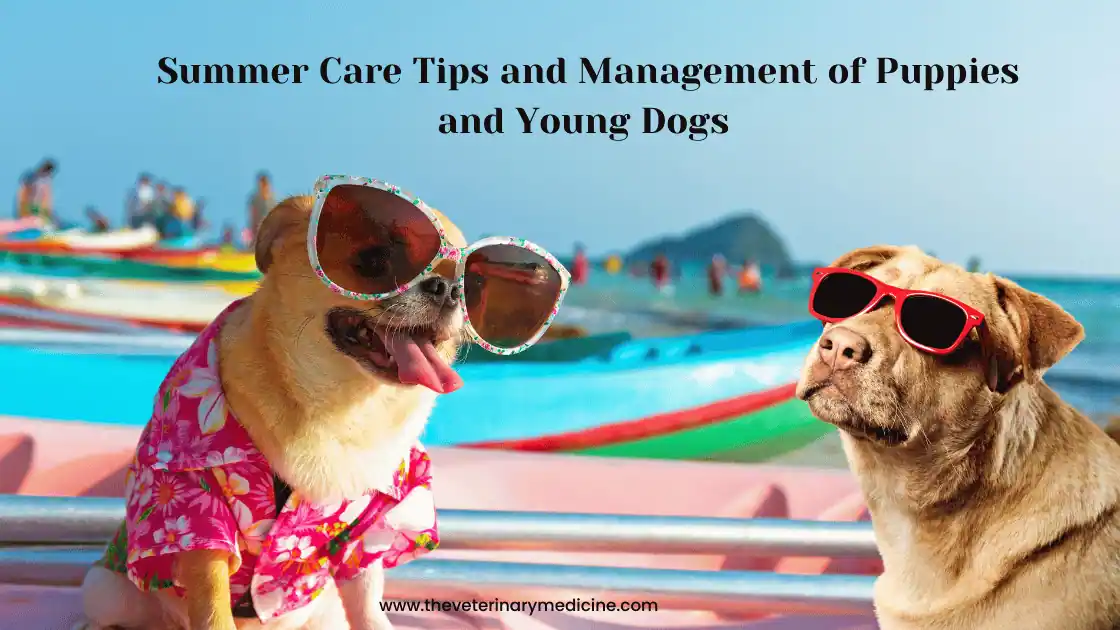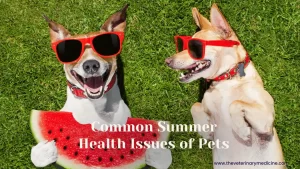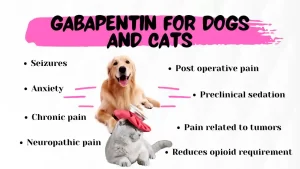Summer season comes with many problems for both pets and humans. Management is the key of happy summer season. During warm temperatures, it is important to ensure that your puppies are well taken care of. The hot weather can present various challenges for puppies from heat stroke to dehydration which can be life threatening. Summer management tips will help your puppies keeping safe, healthy, and happy during the warmest months of the year.
1. Hydration
Puppies/ dogs maintain their body temperature through panting or breathing while keeping tongue out when it’s too hot for them. This leads to rapid dehydration in summers and hydration is one of the most critical aspects of summer care. Puppies are more susceptible to dehydration and heat stroke, so always provide fresh, clean water. Here are some tips to encourage water intake in puppies:
- Multiple Water Stations: Place more than one water bowls filled with clean, fresh, cool water in home or around home and yard. This can increase water intake and prevent dehydration in puppies. Don’t forget to refill them and prefer ceramic bowls which stay cooler than plastic ones.
- Keep and Stay Indoor During Peak Sun Hours: Avoid taking out your dogs for walk or any activity during extreme hot or peak sun hours (11AM to 5PM) of the day. Keep an eye on weather warnings issued or broadcasted by meteorological department using various sources.
- Portable Water Bottles: When on walks or outings, carry a collapsible bowl and portable dog water bottle filled with cold water to keep them hydrated.
- Ice Cubes: You can add ice cubes to their water bowl to keep it cool and enticing. Ice cubes can be made with oral rehydration solutions made for pets or with buttermilk or watermelon juice or water alone as per likings of your pet.
2. Avoid Overheating
Dogs don’t have sweat glands on all over the body or sweat like human. So can easily overheat or exposed to heat stroke, especially puppies who may not yet know their limits or exhaust themselves early. Signs of overheating or heat stress may include excessive panting, drooling, and lethargy. To prevent this incidence:
- Limit Exercise: Avoid exercise during peak hours or take out your puppy during cooler parts of the day, such as early morning or late evening. Schedule walks and playtime for the cooler times of the day.
- Shade and Shelter: Provide ample shade when outside, allow sufficient time for cooling of car or vehicle before leaving and never leave your puppy in a parked car.
- Cool Down Techniques: Use cooling mats, or damp towels for your puppy to lie on and use dog-friendly cooling vests for temperature management or provide cold water for drinking/ ice cubes for licking.
- Keep Indoors Cool: Air conditioning with humidifiers is a life saver for our furry companions during extreme summers. If air conditioning is not possible then use fans and keep windows open for proper ventilation but ensure that arrangements are sufficient to prevent escapes.
3. Sun Protection
Some dog breeds/ dogs have thick fur coats that offer some protection from sun-burn, lighter-coloured pups or those with short or thin fur are susceptible to sunburn. During peak sun hours just like humans, dogs can suffer from sunburn and skin damage due to heat and UV rays. Protect your puppy with these tips:
- Limit Sun Exposure: Limiting sun exposure can help in management. Avoid prolonged periods in direct sunlight, especially during peak sun hours of the day.
- Dog-Friendly Sunscreen: Take out only if necessary and apply pet-safe sunscreen to areas with little fur, like the nose, ears/ ear tips, and belly region. You can consult with your veterinarian for sunscreen recommendations.
- Protective Clothing: Lightweight and light colour dog shirts such as UV blocking shirts can offer an extra layer of protection from the sun’s rays if you are planning to go out.
- Shade Breaks: When planning for outdoor activities ensure your puppy has access to shaded areas like trees, umbrella or canopy to rest during outdoor play.
4. Paw Care
Roads, hot pavements and sand can cause burn injury to your puppy’s sensitive paws. Here’s how to protect them if you need to take your dog out:
- Paw Wax: Apply a good quality paw wax before taking out to protect their pads from hot surfaces and avoid burns. But this may not be so much effective.
- Booties: Use dog booties for walks on hot pavement or sand during day time. Your pet may take time in being used to for boots but this is more effective way to prevent paw burns.
- Check Temperature: Not all the dog breeds have thick foot pads and most of them have soft sensitive skin. Always test surfaces with the back of your hand; if it’s too hot for you, it’s too hot for your puppy also.
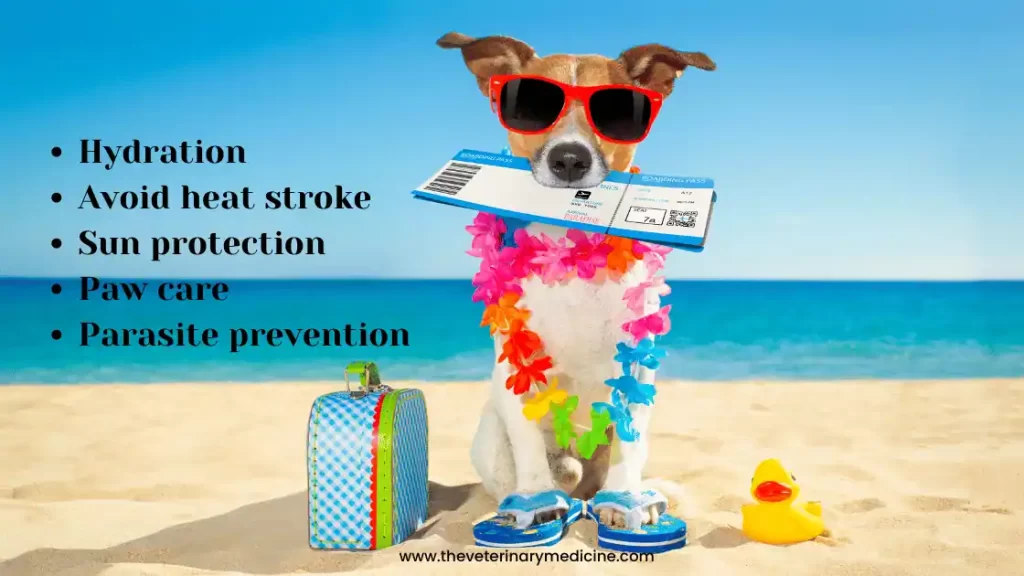
5. Parasite Prevention
Summer is a favourable season and brings a higher risk of fleas, ticks, and mosquitoes with chances of systemic and local problems for pets. Protect your puppy with the following:
- Flea and Tick Prevention: Always keep an eye and if find any ectoparasite then use vet-recommended flea and tick preventatives. All preparations may not be suitable because of age and body weight restrictions for the most of the products.
- Regular Checks: Make it a habit and after outdoor activities, check your puppy for ticks and other parasites specially on ears and paws.
- Heartworm Prevention: Mosquitoes are prevalent in the season and can transmit heartworms, so ensure your puppy is on a preventative medication if living in areas where such cases are reported.
6. Grooming
Regular grooming during summer can help in keeping your puppy comfortable and can prevent heat-related issues:
- Regular Brushing: Brush your puppy regularly to remove excess fur, dead hairs, debris, dirt and to prevent matting.
- Trim, Don’t Shave: While it may be tempting but do not shave your dog’s coat. Their fur helps in entrapping air and making an insulating layer between body and skin which regulate body temperature and protect from sunburn and heat wave.
- Bathing: Bathing can help in reducing heat stress. Bath your puppy with a gentle, dog-friendly shampoo to remove dirt and allergens. Frequency of bathing can be once in a week during summers. Swimming in indoor pools/ kiddie pools can also be relaxing under supervision. Sprinklers can also be an option for a refreshing play and bathing session.
7. Safe Outdoor Activities
Summer is a great time for outdoor fun and activities, but safety should always come first:
- Supervised Swims: Swimming can be most satisfying for your puppy but supervise them closely in pools, lakes, or beaches. Also check after swimming and don’t forget to rinse or bath with clean water if needed.
- Avoid Toxic Plants: Outdoor area, yards and common areas may be having many plants which can be toxic for your puppy. Keep an eye and keep your puppy away from commonly toxic plants and flowers which can help in a safe activity.
- Secure Yard: Play time can bring some emergencies if not secure for your pet. Ensure your yard or play area is secure and free from hazards like sharp objects or small holes.
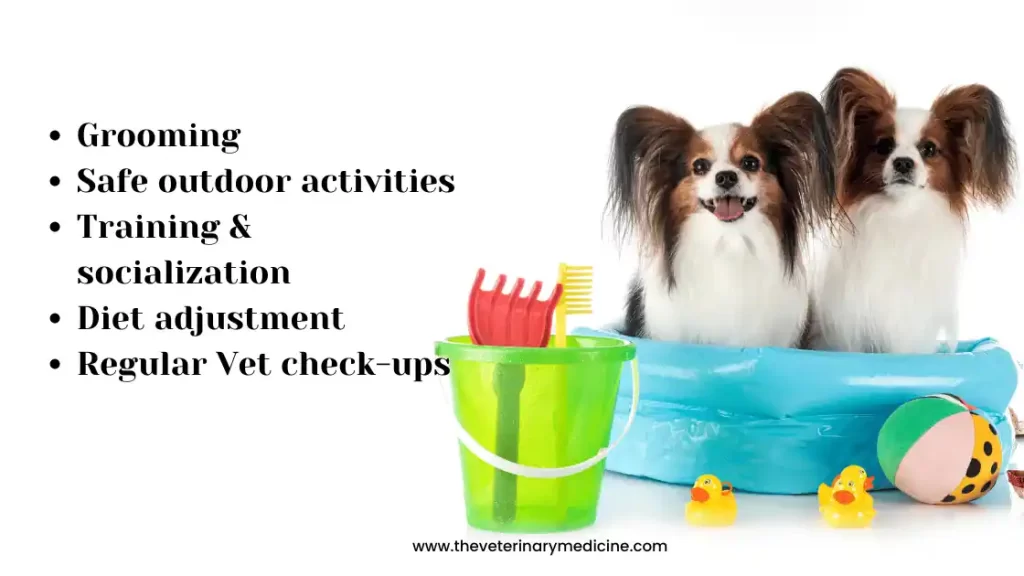
8. Training and Socialization
Reduced mental and physical stimulation can be a reason of developing bad habits. Summer offers more opportunities for socialization and training in different environments:
- Obedience Training: You can continue obedience training in various outdoor settings during cooler times of the day to reinforce good behaviour.
- Socialization: During outdoor activities try to introduce your puppy to new experiences, people, and other dogs to build confidence.
- Safety First: Safety comes first and always use a leash / harness when taking your pet in unfamiliar areas and be mindful of other animals and distractions.
9. Diet Adjustments
Summer stress may bring digestive challenges also and comes with GI challenges. Your puppy’s diet may need slight adjustments during summer:
- Light Meals: Reduce dietary bulk and offer smaller, more frequent meals to avoid digestive issues like partial anorexia, leaving meals sometimes, or indigestion in the peak summer days.
- Hydrating Foods: Incorporate hydrating dog safe fruits or treats like watermelon (seedless), papaya, musk melon, cucumber and butter milk into their diet. Ensure availability of fresh drinking water.
- Frozen Treats: Freeze dog-safe ice creams, fruits, broth, or yogurt in a Kong toy for a delightful and hydrating treat for relief from heat.
10. Regular Vet Check-ups
Summer health issues in pets like ectoparasites, skin problems, dehydration and heat stroke may need vet visits. Regular vet visits are essential to ensure your puppy is healthy and ready for summer fun:
- Vaccinations: Ensure your pet’s vaccinations are up-to-date. Take care of medication, especially those preventing diseases common in summer especially due to ectoparasites or ectoparasite infestations.
- Health Check: If needed or you suspect any illness then schedule and get a thorough health check to address any potential issues early for better management.
Conclusion
Summer season is a wonderful time from outdoor activities to make a stronger bond with your puppy and create lasting memories but challenge comes in form of summer associated problems. Stay vigilant for signs of heat stroke (drooling, lethargy, panting and vomiting). Always keep a first aid kit at hand and carry during outdoor activities. In case of any of the problems related to summer try to do primary management and contact your veterinarian if needed. By following summer tips or few simple adjustments to daily routine, you can ensure that your young dog stays safe, healthy, and happy throughout the season. Remember that your vigilance and care are key to your puppy’s well-being during the season.
*Disclaimer: This article has been authored and reviewed by veterinarians. But always consult with a veterinarian for specific care instructions tailored to your pet’s individual needs.


